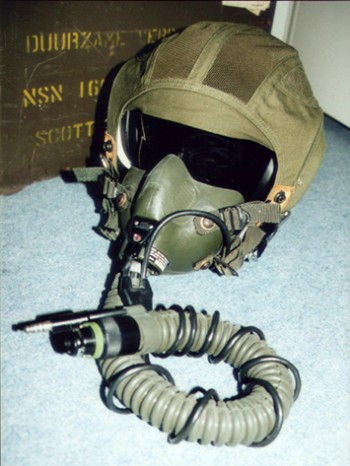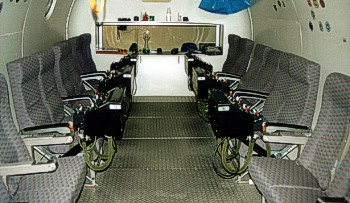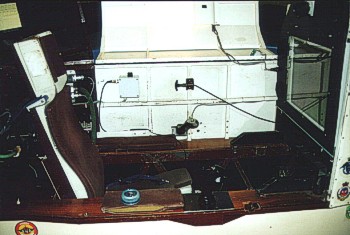Flightgear Online visited the Aero Medical Institute situated in
Soesterberg the Netherlands. Founded fifty years ago to combine all aviation medical
related activities, it now is one of the major institutes in Europe. The institute offers,
among other things, flight physiological training. During Flightgear Online’s visit,
aircrew from the US Airforce, Italian Airforce and Netherlands Airforce were busy with
training. This article will focus on the flight physiological aspect of the institute.

The aim of flight
physiological training is to acquaint aviators with extreme physiological conditions that
can affect bodily and mental functions, and that pose serious hazards to flight safety.
The training enables participants to arm themselves against these extreme conditions, as
well as to recognize bodily symptoms at an early stage and respond to them in an
appropriate way. It promotes confidence and effective operation, and thereby enhances
flight safety.
Three types of flight physiological training are available:
Simulated altitude flights
in the hypo baric chamber with demonstrations of the effects of hypoxia, rapid
decompression, rapid ascent, free fall, and night vision at altitude.
Training under high
sustained "G" forces in the human centrifuge.
Disorientation training,
demonstrating spatial disorientation phenomenon under simulated flight conditions, using a
special simulation device, FSDD.
Hypobaric chambers
The two Hypobaric Chambers of the Aeromedical Institute are high-altitude simulators
capable of being depressurized to an equivalent of 100,000 feet above sea level. These
chambers are primarily used for military and civilian aircrew hypoxia recognition training
and experimental projects.
There is a small chamber of 4m
x 2.5m and a large chamber of 7 m x 2.5 m. In the small chamber 12 trainees and two
instructors can be seated. The seats are equipped with an oxygen hose that attaches
directly to the mask (with inbuilt regulator) or the CRU-60/P and CRU-94/P regulator.
Visiting aircrew use their own equipment or gear being made available by the institute
(see below).
The greater chamber is mainly
used for altitude training of athletes, medical/physiological evaluations, scientific
research, and tests of life support equipment..

The chambers can be used for
“rapid decompression” , e.g. a drop of pressure corresponding with a rise from
10,000 ft to 25,000 ft in 3 seconds.
Applications
The facility is mostly used for high altitude physiological training and hypoxia
familiarization for a wide variety of air personnel. The equipment is also used for
attitude training of athletes who want to improve their performance.
Research projects conducted in
the Hypo baric facility include studies of the effects of drugs on performance under
hypoxia and of the effects of hypoxia on contact lenses. Studies in collaboration with
universities on the effects of altitude-induced hypoxia on human physiology have also been
conducted.
The Hypobaric facility has
been used for diagnostic assessments of medically-restricted aircrew. It is also being
used for testing life support equipment and pressure sensitive devices.
The Flightgear Online team was shown a video tape made the day before our visit showing
some experienced F-15E Eagle pilots from Lakenheath UK in the hypobaric chamber. Also
present with the crew was a female working at the institute who was given a try in the
chamber. The people in the hypobaric chamber were asked to do simple things like filling
out forms and making easy puzzles. One very nice item was a ball with holes in it used by
little children to learn figures. The objective was to place the right figure in the right
hole. Funny to see how difficult that is while suffering from hypoxia. After some time the
F-15E jocks were reaching for their MBU-20/P Combat Edge masks while the female institute
worker was still doing her puzzles in a remarkable good way. I have never seen a well
trained pilot looking so amazed!
The Human Centrifuge
The Human Centrifuge simulates the rapid-onset of sustained G-forces experienced by pilots
flying high performance aircraft, such as the F-16. High sustained G-forces decrease blood
pressure in the head, which may cause a loss of vision and sometimes loss of consciousness
(G-LOC).
The human centrifuge of the Aeromedical Institute has been used since 1983. In 1989 it has
been updated with a new F-16 cockpit configuration in combination with a computer
generated out-world scenery.

Facts and figures
The centrifuge can generate 23,5 G at onset rates of 3.5G/sec. The free swing gondola,
which takes payloads up to 175 kg, is equipped with an adjustable ACES II like seat (with
Alouette helicopter seatbelts) and life support equipment, a side stick, two-way audio
communication and extensive biomedical instrumentation. G-profiles and data acquisition
are computer-controlled. The (candidate) pilot is monitored with online ECG registrations
and with a video camera.

Through training sessions in
the centrifuge jet pilots experience the effects of high G-forces, and learn to combat
these effects using anti-G straining maneuvers (AGSM), possibly in combination with the
anti-G suit.
The centrifuge can be used to simulate in-flight G-exposure in personnel undergoing
medical assessment.
Research projects conducted in the centrifuge include experiments studying the effects of
high G levels on the blood flow to the head, the stability of contact lenses on the eye
and the development of an early warning device of a G-LOC.
New equipment under development have been tested in the centrifuge. One of the new flight
gear items tested is the Libelle liquid filled G-suit (see also the article on this
website). The pilots testing this device made the following report on their ride:
“Speedy, Spout and Miep have been in Soesterberg for a week to have themselves being
thrown around with 9 G’s in the centrifuge. Purpose was the testing of a new G-suit
named Libelle. Spout broke the record by having the centrifuge shut off after 25 seconds
with 9 G. Not because Spout was tired, no, the machine reached its limits and was
automatically turned off. A video has been made showing how Miep looks at fifty and Speedy
having his lips all over the place.”
The FSDD
The Flight Simulated Disorientation Demonstrator (FSDD) acts as a dynamic flight simulator
on an motion base. It has 6 degrees of freedom and a 360 degree rotation freedom around
the vertical axis.
Using the 3D vision system and the mobility of the FSDD most of the known disorientation
phenomena can be demonstrated in IMC and/or VMC flight conditions.
The FSDD is a generic device. It can be flown as a jet aircraft, turbo prop aircraft and
as a helicopter.
Flight Gear
Keeping up with the latest developments in modern flight gear, the institute uses a lot of
different equipment. In the past, the institute was known for using old P series helmets
and was the sole user of the Gueneau 316 in the Netherlands Airforce.
These days the institute uses a cloth helmet made by Gentex. The green helmet has a
complete set of communications and hookup points for the oxygen mask. In the past little
black mask receivers were used but they have been replaced by large pads of Velcro (see
picture below of the MBU-5/P mask). This way of attaching the mask to the helmet allows an
easier adjustment by different users.

Oxygen masks in use are the
MBU-5/P, MBU-12/P and the HA/LP. Interesting is the use of a regulating connector on some
of the masks. These mini regulators can be attached directly to the oxygen hose, so the
use of a separate regulator is not needed (see image with helmet and MBU-12/P).
Flightgear Online wishes to thank Lt.Col. R. Hop and his team for their assistance and
making this visit possible. Some of the text for this article has been taken from
information supplied by the Aero Medical Institute and altered for use. |